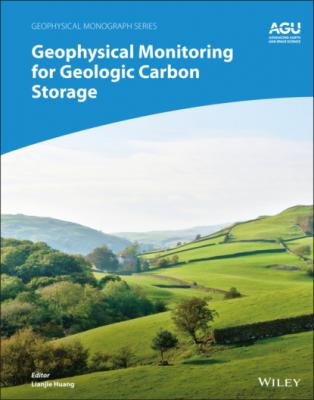Geophysical Monitoring for Geologic Carbon Storage. Группа авторов
Читать онлайн.| Название | Geophysical Monitoring for Geologic Carbon Storage |
|---|---|
| Автор произведения | Группа авторов |
| Жанр | География |
| Серия | |
| Издательство | География |
| Год выпуска | 0 |
| isbn | 9781119156840 |
Note: The core numbers were redesignated in this paper and can be different from what are seen in the photographs.
The first core sample (Carbon Tan #1) was tested for: intact state (Intact I); a mated, core‐parallel fracture (Frac Ia); a sheared (linearly displaced) core‐parallel fracture with end spacers (Frac Ib); and a sheared core parallel fracture without end spacers (Frac Ic). The end spacers (thickness 3 mm) in the Frac Ib test, which were coupled to the sample and the metal rods using thin lead foil disks, were made from the same sandstone and were used to apply and maintain a shear offset along the fracture surface. These spacers were later removed, and the protruding sample ends were ground flat for use in the Frac Ic test. These tests were all conducted while the fracture was oriented horizontally. In addition, the same test as Frac Ic was conducted while the fracture was oriented vertically to examine the effect of buoyancy‐controlled scCO2 migration within the fracture on seismic waves (Frac Id).
For the second core sample (Carbon Tan #2), tests were conducted for: intact state (Intact II); a sheared (rotational offset) core‐perpendicular fracture with a Mylar wrapping (Frac IIa); and the same sample as Frac IIa without the Mylar wrapping (Frac IIb). Note that for Frac IIa test, scCO2 followed a preferential flow path along the Mylar sheet, resulting in premature breakthrough across the core. This test can be viewed as a special case where both core‐perpendicular and core‐parallel fractures are present. However, the permeability of this fast‐pass‐providing core‐parallel “fracture” was thought to be small.
5.2.4. Determination of Elastic Moduli and Attenuation From Measured Resonances
SHRB measurements determine dynamic Young's modulus E, shear modulus G, and their related attenuations (vibration damping factors) a E and a G respectively (given by 1/2Q E and 1/2Q G using the seismic quality factors). Note that for anisotropic rock, E is the longitudinal modulus along the core axis, and G is the torsion modulus around the core axis. During an experiment, fundamental‐mode resonances of both longitudinal‐mode vibration and torsional‐mode vibration are measured, using combinations of longitudinal piezoelectric source and the axial accelerometer, and of the torsional source and the tangential accelerometers, respectively. For each resonance, its peak frequency f c and the half‐power width Δf are measured. From these values, the quality factor of the resonance is obtained by Q –1=Δf/f c . In our experiments, f c and a=1/2 Q values are measured and computed automatically by the spectrum analyzer.
Once the peak frequencies and the quality factors for both longitudinal and torsion resonances are obtained, these are used to invert numerically for the dynamic moduli and attenuations of the rock sample. The code used for the inversion consists of a one‐dimensional, frequency‐domain wave propagation model with multiple, homogeneous segments (layers) with unknown complex Young's modulus and shear modulus for the sample segment (a propagator method, e.g., Aki & Richards, 1980). The other model parameters, such as the dimension and the density of the sample, properties of the steel bars, and source and sensor mass, are measured and known.
The forward modeling code computes accelerations at one end of the model as a function of the frequency, corresponding to either a longitudinal or torsional wave input from the source end. From the ratios between the accelerations and the force (or stress) at the source, simulated frequency response functions are computed. Similar to the experiment, the central frequencies and the half‐power widths of simulated resonance peaks are measured. Once both experimentally measured and numerically computed central frequencies and half‐power widths of longitudinal and torsional resonances are obtained, the elastic moduli (from the differences in the central frequencies) and the related attenuations (from the differences in the peak widths) in the model are adjusted so that the differences becomes smaller. Using these new parameters, corrected frequency response functions are computed and updated resonance frequencies and half‐power widths are obtained. This process is repeated until the differences between measured and computed central frequencies and the peak widths become sufficiently small.
More details of the numerical modeling and the inversion procedure, including examples for synthetic materials (acrylic and polycarbonate samples), are presented previously (Nakagawa, 2011). In Figure 5.3, examples of experimentally measured frequency response functions (measured accelerometer voltage outputs normalized by the source input voltage of the spectrum analyzer) are shown, along with fitted, numerically simulated frequency response functions. The sample is an intact, dry, Carbon Tan #1 core, under a confining stress of 9.6 MPa.
